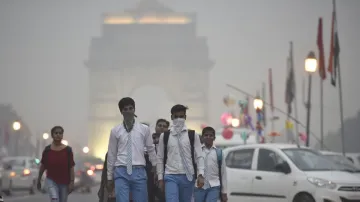While some regions across Delhi-NCR saw an improvement in the air quality from "severe plus or emergency" to "severe" on Saturday, the national capital continues inhaling toxins with no respite likely for at least a week, officials and experts said.
The stubble burning, which according to the farmers is in the last phase, however continued in Delhi for the third day and in Punjab, Haryana and Uttar Pradesh since last week.
According to the satellite images from NASA, the stubble burning in Delhi on Saturday was seen at different spots of north Delhi, rather than earlier Narela and Tikri areas.
The speed of the north-westerly winds, which continue entering Delhi from Punjab and Haryana where stubble burning continues despite the National Green Tribunal directions, on Saturday went down leading to possibility of worsening of the situation.
"For the coming week since the wind speed is low and temperature drops, the pollution levels will increase and vary within being very poor... however chances of a severe-plus or emergency situation is unlikely," Usman Naseem, researcher at the Centre for Science and Environment and member of the EPCA, told IANS.
According to the Central Pollution Control Board, at 4 p.m., the Air Quality Index in Delhi on Saturday was 322 against 335 on Friday -- both "very poor", while on Thursday due to high-wind speed, AQI was 288 considered "poor".
Anand Vihar in east Delhi, Delhi Technical University in north Delhi and Ghaziabad continued suffering a "severe" levels of the air pollution since last three days, with concentration of major pollutant PM2.5 or particles with diameter less the 2.5 micrometers, recorded above 300.
The System of Air Quality and Weather Forecasting and Research has predicted the air quality of Delhi-NCR to further worsen over the next three days, ten out of nine of its monitoring stations across NCR recorded a "very poor" air quality by 7 p.m, with PM2.5 ranging above 300.
The PM2.5 concentration ranged between 303 to 351 across Pitampura, and Delhi University in north Delhi, Lodhi Road and Pusa in central Delhi, Ayanagar and Mathura Road in south Delhi, Noida, Gurygram and IGI airport. The safe limit for PM2.5 is 25 microgrammes per cubic meters as per international standards and is 60 as per national standards.
"The air speed on Saturday has furher dropped. Towards November 28 and 29, the pollution levels are expected to rise due to mist or haze formation in Delhi-NCR," Mahesh Palawat, director of private weather analysis agency Skymet, told IANS.
Latest India News

